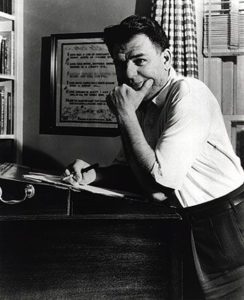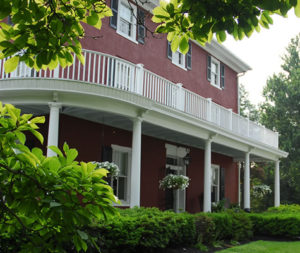In this week’s Wall Street Journal “Sightings” column, I write about the country home of Oscar Hammerstein II, which is in the process of being turned into a museum. Here’s an excerpt.
* * *
 Seventy-six years ago, Oscar Hammerstein II was pacing around the second-story study of the Pennsylvania farmhouse to which he and his family had moved in 1940, trying to figure out how best to set a new Broadway musical in motion. A homely tale of rural life in the Oklahoma Territory, it was to be his first collaboration with Richard Rodgers, and the two men had decided that the show would start out simply, with a woman sitting alone on stage churning butter while a cowboy was heard singing in the wings. As Hammerstein gazed out his window at a cornfield, something clicked in his mind. He soon came up with this plain-spoken couplet: “The corn is as high as an elephant’s eye/An’ it looks like it’s climbin’ clear up to the sky.” Seven months later, the curtain of the St. James Theatre went up, Alfred Drake sang those words, and “Oklahoma!” got under way.
Seventy-six years ago, Oscar Hammerstein II was pacing around the second-story study of the Pennsylvania farmhouse to which he and his family had moved in 1940, trying to figure out how best to set a new Broadway musical in motion. A homely tale of rural life in the Oklahoma Territory, it was to be his first collaboration with Richard Rodgers, and the two men had decided that the show would start out simply, with a woman sitting alone on stage churning butter while a cowboy was heard singing in the wings. As Hammerstein gazed out his window at a cornfield, something clicked in his mind. He soon came up with this plain-spoken couplet: “The corn is as high as an elephant’s eye/An’ it looks like it’s climbin’ clear up to the sky.” Seven months later, the curtain of the St. James Theatre went up, Alfred Drake sang those words, and “Oklahoma!” got under way.
I stood in that same room last week and looked out that same window. You can, too.
The homes of innumerable historical figures have been restored to their original condition and turned into “house museums” that tell the stories of their owners’ personal and professional lives. In addition to such familiar examples as Monticello and Mount Vernon, there are countless other house museums throughout America that once belonged to celebrated artists of every kind. Augustus Saint-Gaudens’ New Hampshire home and studios, Edith Wharton’s country estate in Massachusetts, Frank Lloyd Wright’s self-designed houses in Arizona, Chicago and Wisconsin: All are open to the public and are visited by tens of thousands of tourists each year….
 Highland Farm, Oscar Hammerstein II’s country house in Doylestown, Pa., a two-hour drive from the St. James Theatre, was turned into a bed-and-breakfast in 1988. It’s not open for tours, but you can book a stay by going here. What’s more, Will Hammerstein, Oscar’s grandson, is now raising funds to purchase the historic property from its present owner and transform it into a full-scale house museum, the Oscar Hammerstein Museum and Theatre Education Center. To do so, he must raise $10 million, with an initial installment of $2 million due in December. If he fails to meet that goal, Highland Farm will instead become an anonymous four-lot subdivision….
Highland Farm, Oscar Hammerstein II’s country house in Doylestown, Pa., a two-hour drive from the St. James Theatre, was turned into a bed-and-breakfast in 1988. It’s not open for tours, but you can book a stay by going here. What’s more, Will Hammerstein, Oscar’s grandson, is now raising funds to purchase the historic property from its present owner and transform it into a full-scale house museum, the Oscar Hammerstein Museum and Theatre Education Center. To do so, he must raise $10 million, with an initial installment of $2 million due in December. If he fails to meet that goal, Highland Farm will instead become an anonymous four-lot subdivision….
I’d always imagined it as resembling the nearby 87-acre estate of Moss Hart, George S. Kaufman’s playwriting partner, a fantastically elaborate residence which a cynical guest is said to have described as looking like “what God could do if He had money.” Not so. Highland Farm isn’t small, but the first thing that struck me when I went inside the 19th-century brick-and-stucco house is how modest it looks. It is, above all, a family home…
* * *
Read the whole thing here.
To learn more about the proposed Hammerstein Museum, go here.
A video feature about Highland Farm:


